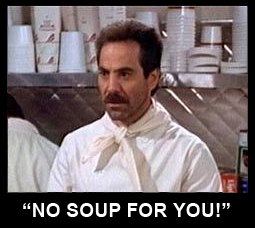Close the gap in your sales and marketing messaging at every level of the organization with employee engagement and regular, effective communication.
I was reading an article today called What the Soup Nazi Taught Me About Brand Messaging, referring to the Seinfeld television character, and I thought , “This is what Steve Moran has been talking about when he goes out on his secret shopper visits with his dad…” there is a serious lack of communication. Ryan Ahistrom, the author of the article, covers much ground on the disconnect between customer promise and customer delivery – during the sale! But what intrigued me was the clear breakdown in communication at every level of the “Soup Nazi’s” organization – even though he had only three employees – and how important it is to make sure in-house communications are top notch within a large, diverse, geographically sprawling organization.
The Importance of In-house Communication
Without good in-house communication, what you get is a lost lead from a secretary who doesn’t know you’re running a promotion. A sale that doesn’t go through because the kitchen didn’t know there were three important tours. Or the physician who can’t get answers about your home care stats on hip replacements because the receptionist doesn’t know where to find the information or doesn’t realize how important it is.
Keeping Employees in Your Corner
So, what’s the solution? Close the gap in your sales and marketing messaging at every level of the organization with employee engagement and regular, effective communication. According to DeskAlerts, a massive 72 percent of all US workers are not engaged with their work and their employers. And, in many cases, the 28 percent who are engaged are senior level executives who have a greater stake in the company.
The result is a huge problem facing the nation’s brands: up to $540 billion is lost as a direct result of employee disengagement every single year. That’s huge!
And, as for communication, most companies try to close the gap with a marketing campaign flier, email, or morning staff meeting. This can often to lead to employees not understanding the big picture. Result: they don’t understand branding, messaging, or tactics that they should be ready to convey.
Internal Culture Builds External Perception
It’s hard for businesses to be consistent internally or externally when the message on the outside doesn’t look or sound like the message on the inside. Make sure the two are aligned. Here are some ways to do that:
- Ask questions – Ask employees what they think they would need to say to convince someone to come to your facility – and then ask what they think they’d need to do to help that happen. Might be an interesting conversation.
- Tell stories – Help every employee understand their importance in the role of census and occupancy – it’s not just the sales director or marketing manager or discharge coordinator’s job – everyone has a part to play. Give them examples. Why? Stories make things real for people.
- Walk the talk – Yes, I’m talking to you, senior management. We all know that actions always speak louder than words. Every interaction, no matter how small, is an opportunity to affirm the importance of never letting a lead or a sale “get away” because you’re too busy to take a minute to talk to a customer.
- Spread the word – It’s all too common that the body doesn’t know what the head is doing. Take steps to ensure that everyone is sending out consistent messages. Then, be sure to celebrate every time a non-sales employee wins a sale. Mention it in company newsletters, staff emails and morning meetings.
- Gather insight from inside – Put out a suggestion box just for sales and marketing ideas. Make sure that your non-sales employees know that you want to hear from them.
We want to hear from you! Instead of a poll this week,. Just tell us your best (and worst) stories of how non sales staff helped or hindered the process in your organization. Reply to me at [email protected]. I’m making lists and sharing at the summit! Join our conversation on the state of senior care marketing here. And don’t forget, we’ll be meeting at the Senior Care Marketing and Sales Summit HQ (SMASH) in Chicago in November.
If you like this article (or even if you don’t) it would be a great honor to have you subscribe to our mailing list HERE









Excellent piece. Lots of good helpful information. One point I might add is that many prospects come in to visit on the weekend. Who is trained to tour the prospects? How do they juggle caring for the residents and helping visitors?
Very good comparison!! So true!